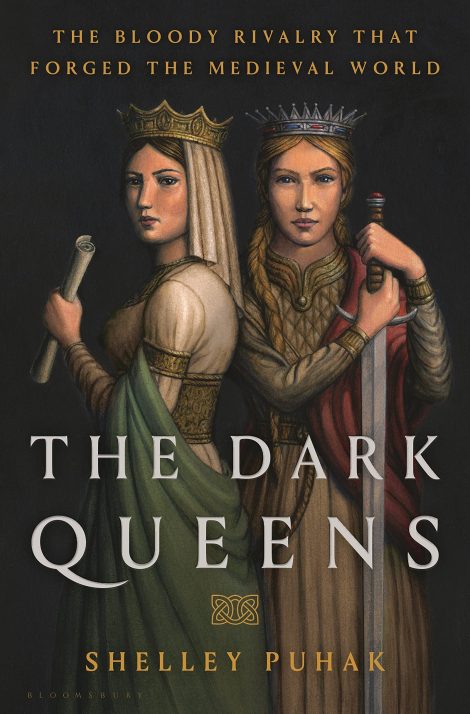
THE DARK QUEENS
The Bloody Rivalry That Forged the Medieval World
The remarkable, little-known story of two trailblazing women in the Early Middle Ages who wielded immense power, only to be vilified for daring to rule.
Brunhild was a foreign princess, raised to be married off for the sake of alliance-building. Her sister-in-law Fredegund started out as a lowly palace slave. And yet-in sixth-century Merovingian France, where women were excluded from noble succession and royal politics was a blood sport-these two iron-willed strategists reigned over vast realms, changing the face of Europe.
The two queens commanded armies and negotiated with kings and popes. They formed coalitions and broke them,
The remarkable, little-known story of two trailblazing women in the Early Middle Ages who wielded immense power, only to be vilified for daring to rule.
Brunhild was a foreign princess, raised to be married off for the sake of alliance-building. Her sister-in-law Fredegund started out as a lowly palace slave. And yet-in sixth-century Merovingian France, where women were excluded from noble succession and royal politics was a blood sport-these two iron-willed strategists reigned over vast realms, changing the face of Europe.
The two queens commanded armies and negotiated with kings and popes. They formed coalitions and broke them, mothered children and lost them. They fought a decades-long civil war-against each other. With ingenuity and skill, they battled to stay alive in the game of statecraft, and in the process laid the foundations of what would one day be Charlemagne’s empire. Yet after the queens’ deaths-one gentle, the other horrific-their stories were rewritten, their names consigned to slander and legend.
In The Dark Queens, award-winning writer Shelley Puhak sets the record straight. She resurrects two very real women in all their complexity, painting a richly detailed portrait of an unfamiliar time and striking at the roots of some of our culture’s stubbornest myths about female power. The Dark Queens offers proof that the relationships between women can transform the world.
- Bloomsbury Publishing
- Hardcover
- February 2022
- 384 Pages
- 9781635574913
About Shelley Puhak

Shelley Puhak is a critically acclaimed poet and writer whose work has appeared in the Atlantic, Lapham’s Quarterly, Teen Vogue, Virginia Quarterly Review, and elsewhere. Her essays have been included in The Best American Travel Writing and selected as Notables in four consecutive editions of The Best American Essays. She is the author of of two books of poetry, most recently Guinevere in Baltimore, winner of the Anthony Hecht Prize. The Dark Queens is her nonfiction debut. She lives in Maryland.
Praise
“A lyrical and astute assessment of the political maneuvers, battlefield strategies, and resilience of medieval queens … Puhak skillfully draws on contemporaneous sources, including letters, poems, and an obviously biased account by Brunhild’s devoted ally, Bishop Gregory of Tours, to create her thrilling history. The resulting is a fascinating portrait of the early Middle Ages that reclaims two powerhouse women from obscurity.”―Publishers Weekly (starred review)
“Medieval history at its most fun. Game of Thrones, eat your heart out!” ―Napa Valley Register
“A compelling read for those with an interest in early medieval European history, Merovingian history, and women in power.” ―Library Journal
“Engaging … fast-paced and intriguing.” ―Booklist
“A well-researched and well-told epic history. The Dark Queens brings these courageous, flawed, and ruthless rulers and their distant times back to life.” ―Margot Lee Shetterly, New York Times-bestselling author of Hidden Figures
“History owes more to Brunhild and Fredegund, two queens whose bitter rivalry left a trail of bodies in their wake, than the lies perpetuated by their enemies. So bravo to Shelley Puhak for a remarkable piece of detective work, by turns enlightening and shocking. Anyone who thought that medieval queens spent their time sewing and sighing is in for a surprise.” ―Amanda Foreman, New York Times–bestselling author of Georgiana: Duchess of Devonshire and The World Made by Women
“This is the story-told with a sharp eye, at heart-pounding pace-of two extraordinary women who held power in a brutal world that believed their sex couldn’t rule. Many scholars ‘still don’t know what to do’ with Brunhild and Fredegund. Shelley Puhak does.” ―Helen Castor, author of She-Wolves and Joan of Arc
Discussion Questions
1. Why does Shelley Puhak call Brunhild and Fredegund the Dark Queens?
2. What can the erasure of Brunhild and Fredegund tell us about how history is written?
3. The Dark Queens is a work of narrative nonfiction, based on primary sources that have many gaps. Take a look at the endnotes for chapter 1, “A Wedding in Metz,” on page 298. How did Puhak use inference to fill in gaps and shape the scene of Brunhild and Sigibert’s wedding? What do those details add?
4. In Francia, 561, the Merovingians (Charibert, Guntram, Sigibert, and Chilperic) were poised for conflict. Why?
5. Who was Brunhild? Describe her. Why did she find herself in Metz?
6. In contrast to Brunhild’s introduction, Fredegund’s is indirect, with her name mentioned every now and then before chapter 6, where she gets her own chapter. What is the effect of this trickle of information before a full introduction?
7. Chapter 5, “A Missive to Byzantium,” ends with Galswintha’s death and Chilperic’s hasty marriage to Fredegund. Puhak describes her as “arrayed in the brightly dyed linens and jewels of her predecessor . . . smiling up at Chilperic.” What does this description tell us about Fredegund?
8. Throughout The Dark Queens, Brunhild and Fredegund would find themselves at odds with each other. Talk about some of the reasons why they might not like the other.
9. What were some of the ways that both queens held on to power? List some of them. Were they successful?
10. The question of an heir was also a focus in both queens’ lives. Why was it so important for both women, especially Fredegund, to produce and raise a son? What was at stake for both women?
11. Fredegund was known to have ordered assassinations of her rivals for power. Compare that to her military talents later on in the book. What does this tell us about Fredegund? Why did she resort to something as clandestine as poison in her earlier years?
12. Talk about some of the Merovingian princesses in the book. What kind of power and agencies did they have?
13. What were some of the ways that society tried to control women during the time? How did both women subvert these?
14. Fredegund and Brunhild died in very different ways. How did each death make us feel?
15. As Puhak mentions, current Western society still has no idea what a prolonged period of female leadership looks like. Now that we’ve read about Brunhild and Fredegund, what can we learn about female power?
